
Sept '20
The IUP Journal of Case Folio
Archives
Domino's Pizza: Business Continuity Strategy During the Covid-19 Pandemice
Debapratim Purkayastha
Director, IBS Case Research Center, IBS Hyderabad, Telangana, India. E-mail: debapratim@ibsindia.org
Hadiya Faheem
Freelancer, Hyderabad, Telangana, India. E-mail: research@icmrindia.org
The case discusses the American multinational pizza giant Domino's Pizza, Inc.'s (Domino's) strategy during the Coronavirus pandemic in 2020. Domino's resorted to a 'Contactless' delivery initiative, which it launched in January 2020 in the wake of the novel Covid-19 outbreak that started in Wuhan, China, and soon spread to countries across the world. With increasing awareness about the virus, consumers were taking precautions to prevent transmission of the disease and were remaining indoors. Many restaurants were closed and the governments of all countries allowed only takeout and delivery. Since Domino's had a strong delivery infrastructure and digital customer base who knew how to order online, it was well-positioned to tackle the crisis. Some analysts appreciated Domino's for its contactless delivery model, as it was helping the pizza giant to thrive during the Covid-19 crisis. To cater to the increasing demand from consumers, Domino's was planning to hire 10,000 new workers in the US. However, it also attracted the ire of critics who felt that the company was putting its employees at the risk of contracting the virus. There were also instances of some of its employees contracting Covid-19. With this being early days of the pandemic, some analysts opined that it could be a tough road ahead for Domino's as the company had to grapple with the full impact of the Covid-19 pandemic. .
I remain highly confident in our strategy and optimistic about the opportunity and potential of our business. Our solid, resilient business model and strong financial position will continue to serve us well in these challenging times.1 – Ritch Allison, CEO, Domino's Pizza, US, in March 2020 The restaurant chain is a tech leader within the food services industry and weathering the COVID-19 crisis well.2 – Anne Burdakin, The Motley Fool, in March 2020 On March 31, 2020, American multinational pizza giant Domino's Pizza, Inc. (Domino's) released preliminary sales results for the first quarter-ended March 22, 2020 (see Exhibit I). It reported same-store sales growth of 1.6% for its US stores and 1.5% for its international stores.3 While most dine-in restaurants were grappling with
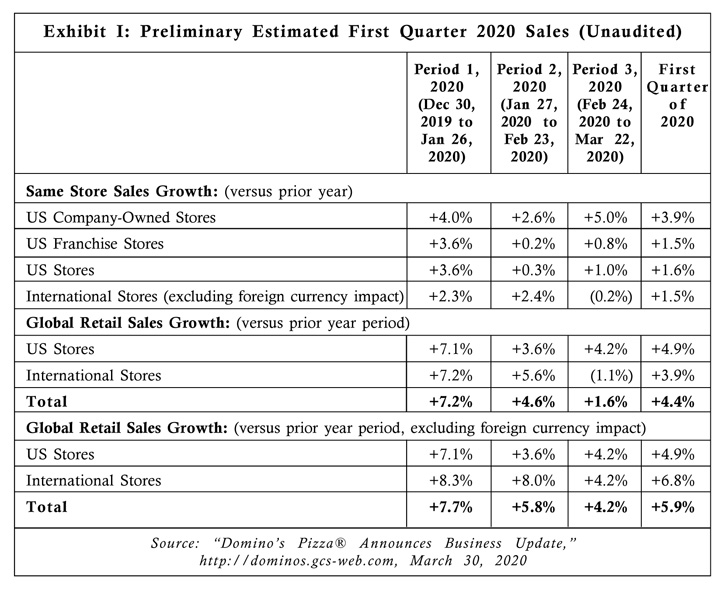
the impact of the novel Covid-19a pandemic on their sales, Domino's was one of the few companies which had not experienced a significant downturn. This was attributed to its prowess in delivery and a new initiative-'Contactless' delivery at all its US as well as international stores. Commenting on the results, Ritch Allison (Allison), CEO of Domino's, US, said, "Across the globe, Domino's will remain focused on execution, service and value as we continue to navigate through the headwinds created by
COVID-19. We are carefully managing our balance sheet, cash flow and all areas of the business to ensure we are doing what we believe will help us best manage through the near-term and, as always, position ourselves for long-term success".4
The Covid-19 crisis started in December 2019 in Wuhan, China. With awareness about the virus increasing, consumers had begun taking precautions to prevent transmission of the disease. With no cure or established treatment for the infection in sight, people in many countries were forced to stay indoors. While this affected many industries, the restaurant industry was badly hit as they were no longer allowed to serve dine-in customers. Worldwide, governments only allowed the food services industry to fulfill takeout and delivery orders. Domino's too was going through disruption with its 14 international markets closed and 23 international markets experiencing partial store closures. This represented around 1,400 international stores, with key markets such as France, Spain, New Zealand and Panama accounting for nearly 900 of these temporary store closures.5
Analysts felt that Domino's was, however, better positioned to tackle the crisis as delivery was not new to its business. Banking on its strong delivery infrastructure, Domino's launched contactless delivery in January 2020 whereby consumers could choose the contactless delivery option while ordering food online. The delivery boy would then leave the food outside the consumer's home and wait at a distance to ensure that the order was picked up. Analysts appreciated the contactless delivery model as it was helping the pizza giant survive during the Covid-19 crisis. In fact, to cater to the increasing demand from consumers, Domino's was planning to hire 10,000 new workers in the US.6 However, the company also faced criticism for putting its employees at risk by expecting them to come to work at a time when most people were being asked to stay indoors.
With this being early days of the pandemic, some critics opined that it could be a tough road ahead for Domino's as the company would have to grapple with the full impact of the Covid-19 pandemic. Would it be able to come out successful from this public health crisis? Going forward, how should it balance the need for providing its service to customers with the need for keeping its employees and customers safe? How should Allison and the senior management team at Domino's ensure business continuity amidst the pandemic?
Background Note
The history of Domino's Pizza (Domino's) dates back to the late 1950s, when Dominick DeVarti (DeVarti) started a small pizza store called DomiNick's Pizza on the Eastern Michigan University campus in Ypsilanti, Michigan. In 1960, two brothers who were students of the University of Michigan, Thomas S Monaghan (Thomas) and James S Monaghan (James), bought the store for $900. In 1961, James sold his share of the business to Thomas.
The pizza business did well and by 1965, Thomas was able to open two more stores in the town-Pizza King and Pizza from the Prop. In 1966, DeVarti opened a pizza store in a neighboring town with the same name, DomiNick's Pizza. Thomas therefore decided to change the name of his store to Domino's Pizza (Domino's). The advantage of this name, Thomas felt, was that it would be listed after DomiNick in the directory. Domino's philosophy rested on two principles-a limited menu and the delivery of fresh, hot pizzas within half an hour. In 1967, it opened the first franchise store in Ypsilanti, and in 1968, a franchise store in Burlington, Vermont.
In 1982, Domino's established Domino's Pizza International (DPI) that helped in opening Domino's stores internationally. The first store was opened in Winnipeg, Canada. In 1983, DPI spread to more than 50 countries and in the same year, i.e., in 1983, it inaugurated its 1000th store. Around the same time, new pizza chains like Pizza Hut and Little Caesar had appeared on the scene and begun to establish themselves in the US. Domino's Pizza faced intense competition because its menu of traditional hand-tossed pizza had remained unchanged over the years. The other pizza chains, however, offered low-priced breadsticks, salads and other fast food apart from pizzas. In the home delivery segment too, Domino's faced tough competition from Pizza Hut, while Little Caesar was eating into Domino's market share with its innovative marketing strategies.
By 1989, Domino's sales had fallen significantly and its cash flows were affected due to the acquisition of assets. In 1993, Thomas decided to expand the Domino's product line in an attempt to revive the company and tackle competition. The company introduced pan pizza and bread sticks in the US. In late 1993, it introduced the Ultimate Deep Dish Pizza and Crunchy Thin Crust Pizza. In 1994, it rolled out another non-pizza dish-Buffalo Wings. Though Domino's did not experiment with its menu for years, it had adopted innovative ways of managing a pizza store. Thomas gave about 90% of the franchisee agreements in the US to people who had worked as drivers with Domino's. The company gave ownership to qualified people after they had successfully managed a pizza store for a year and had completed a training course. Domino's also gave franchises to candidates recommended by existing franchisees. Outside the US, most of Domino's stores were franchise-owned. Domino's was also credited for many innovations in the pizza industry and for setting standards for other pizza companies. It had developed dough trays, corrugated pizza boxes, insulated bags for delivering pizzas and conveyor ovens.
In 1993, Domino's withdrew the guarantee of delivering pizzas within 30 minutes of ordering and started emphasizing Total Satisfaction Guarantee (TSG) which read, "If for any reason, you are dissatisfied with your Domino's Pizza dining experience, we will re-make your pizza or refund your money."
In 1996, Domino's launched its website. In 1996, it also entered India through a franchise agreement with Jubilant FoodWorks Ltd.,b in Delhi. With the overwhelming success of the first outlet, the company opened another outlet in Delhi. By 2000, Domino's had outlets in all the major cities in India.
In 1998, Domino's introduced a patented pizza delivery bag that was designed to keep pizzas oven hot until they were delivered to the customer.
In 2001, Domino's opened its 7000th restaurant in Brooklyn, New York. In 2002, it acquired 82 franchised restaurants in Phoenix, Arizona. This was the largest restaurant acquisition in the company's history.
In 2004, Domino's was listed on the New York Stock Exchange and became a public traded company.
In 2007, it became the first company in the Quick Service Restaurantc industry to offer ordering of pizzas through mobile phones. Customers could order from around 2,500 of Domino's 5,128 stores in the US on mobile-dominos.com. Commenting on the launch, Rob Weisberg, Domino's Vice-President of precision and print marketing, said, "With so many people living life on-the-go, Domino's mobile ordering delivers even more convenience for our customers' busy lifestyles. With the addition of yet another order-taking channel, Domino's is thrilled to lead the market with this breakthrough technology that continues to change the way people think about ordering pizza."7
In 2008, Domino's started an online application called Pizza Tracker, which enabled consumers to track the delivery of their pizzas in real time.
In 2016, Domino's in cooperation with California-based self-driving robotic delivery vehicles company Starship Technologies began supplying pizzas through self-driving robots in some of Dutch and German cities. The same year, i.e., in 2016, Domino's notched up another first by delivering a pizza in New Zealand using an unmanned aerial vehicle using DRU Drone by Reno, Nevada, US-based drone delivery company, Flirtey. Domino's used the DRU Drone as a delivery method and integrated the drone with online ordering and GPS systems. Commenting on the initiative, Domino's Group Australia CEO and Managing Director Don Meij said, "Drones offer the promise of safer, faster deliveries to an expanded delivery area, meaning more customers can expect to receive a freshly-made order within our ultimate target of 10 minutes. This is the future."8
In April 2018, Domino's announced that it was adding 150,000 HotSpots to its delivery locations, which would enable pizza to be delivered to customers in a beach, park, museum, etc., without the need for a physical address.9
In June 2019, Domino's teamed up with California-based robotics company, Nuro, to launch a pilot for driverless pizza delivery in Houston, Texas. The pizza giant aimed to use Nuro's driverless fleet of custom-built robot cars to deliver pizzas to residents in Houston who placed online orders.
In 2019, Domino's recorded total sales of $14.3 bn with international markets accounting for $7.3 bn (see Exhibit II). It had more than 17,000 stores in over 90 markets. Its key international markets included Australia, India and the UK. Independent franchise owners accounted for 98% of its stores as of December 2019 (see Exhibit III).10 In the US, Domino's had 6,126 stores, of which 5,784 were owned by franchisees. Analysts felt that Domino's was a poster boy for globalization and franchising with 104 consecutive quarters of positive same-store sales growth. As of March 2020, Domino's and its franchisees employed around 400,000 people worldwide.11
The Covid-19 Pandemic
Covid-19 was closely related to the Severe Acute Respiratory Syndrome (SARS) which started in China in 2002. The SARS virus infected around 8,000 people and killed 800. Another coronavirus was the Middle Eastern Respiratory Syndrome (MERS) that emerged in Saudi Arabia in 2012. There were around 2,500 infected cases and 900 deaths due to MERS.
Covid-19 was different from SARS and MERS in that 80% of the people affected by it reported only a mild infection. However, many people carried the disease without displaying any symptoms, which made it difficult to control its spread.
The Covid-19 outbreak started in a wet market in Wuhan, which sold fish, birds, and both live and dead animals. With live animals being kept and butchered on site, it
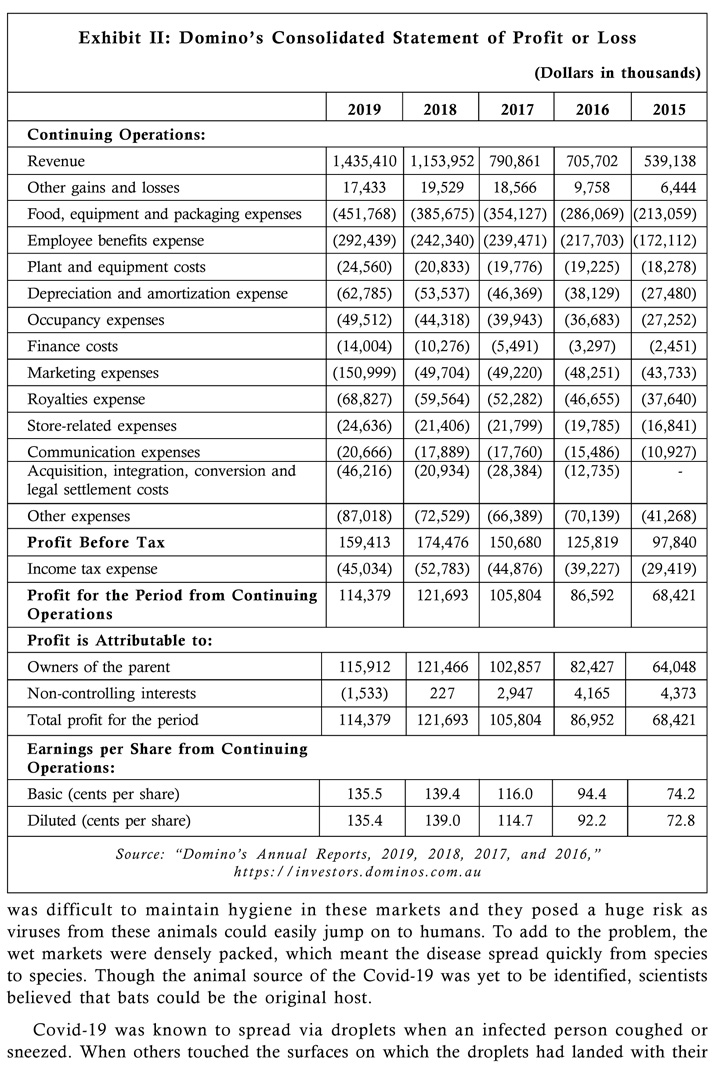
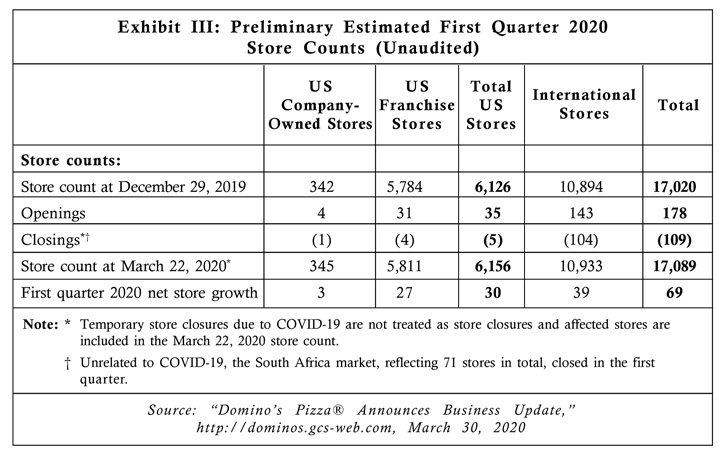
With no treatment options in sight, governments across the world were relying mostly on social distancing to arrest the spread of the disease. Many governments had imposed lockdowns, only allowing essential businesses to operate. This had led to massive disruptions in business. Analysts expected the restaurant business to be hit hard by the pandemic, as states in the US and elsewhere forced restaurants to limit service to takeout and delivery in an effort to keep people from clustering together to prevent transmission of the disease. According to the National Restaurant Association, out of the one million restaurant locations in the US, about 3% had already closed permanently, with another 11% anticipating closure by the end of April. They felt that restaurants with delivery would fare marginally better.15
Domino's Launches 'Contactless' Delivery
Domino's former CEO, Patrick Doyle, had famously said that Domino's was a tech company that sold pizzas. However, analysts felt that it had remained true to the company's core competency: pizza.
Domino's, which accounted for a 36% market share in the US, had always been an advocate of the delivery and takeout model rather than offering the dine-in facility to its consumers. As of January 2020, delivery accounted for 55% of its sales while carry out accounted for the remaining 45% of the sales.16 The pizza chain also had an advantage as most of its consumers had the ability to order online. In the US, Domino's garnered 65% of its sales through digital channels such as Facebook Messenger, Google Home, Apple Watch, Twitter, and Amazon Echo, in addition to its own ordering platform, Domino's Hotspots, that offered service to over 200,000 non-traditional delivery locations. Analysts felt that Domino's was well-positioned to tackle the Covid-19 crisis with its dedicated delivery workforce and a customer base which was accustomed to ordering online. According to R J Hottovy, an analyst with Morningstar, Domino's "infrastructure is set up for something like this."17
With health concerns growing due to the Covid-19 pandemic, Domino's decided to bank on its strong delivery infrastructure and in January 2020, it announced its plans to offer contactless delivery. This meant that the pizza chain delivery person would deliver the food to a consumer without any contact or interaction between them in a bid to ensure safety. Explaining the contactless delivery policy to its consumers, Allison said, "We also want to make sure that customers know that we will deliver any way they choose. Whether they prefer a delivery left at the front door or at a reception desk, our delivery instruction box is the place to put any special directions. We know many people would like to choose contactless delivery right now and we want customers to know we are here to deliver."18
Domino's ensured that all its employees were complying with the hygiene and safety protocols across all its restaurants which were open for delivery worldwide. The pizzas were cooked in an oven at 260 degree Celsius and was then packed for delivery and were not touched by human hands. In addition to this, temperature screening was done of all its employees and the delivery fleet was asked to use face masks. Domino's was constantly sanitizing its restaurants, delivery bikes, delivery bikes' boxes, and pizza delivery hot bags to assure consumers that the food delivered by them was safe.
Domino's launched contactless delivery across the majority of its US as well as international stores. In India, the company's licensee, Jubilant FoodWorks Ltd (JFL), launched zero-contact delivery across all its 1,325 restaurants.19 In addition to this, Domino's partnered with India's fastest growing FMCG company ITC Foods (ITC) to launch an initiative known as 'Domino's Essentials' wherein consumers could order groceries and other essentials by downloading the Domino's app. The service was launched after the Government of India announced a 21-day lockdowng in the country from March 25, 2020, to April 14, 2020, due to the Covid-19 pandemic. On April 14, the lockdown was extended till May 3, 2020, as the country reported more than 10,000 Covid-19 cases and 339 deaths, commenting on the initiative, Pratik Pota, CEO and whole-time Director, JFL, said, "We will use the Domino's supply chain and delivery network to deliver essential goods such as Aashirvaad Atta [flour], spices, etc. at people's doorstep. Customers can order using the Domino's App and their order will be delivered safely and hygienically using Zero Contact Delivery."20
After placing the order on the Domino's delivery app, consumers could make the payment by digital mode to complete the order. The delivery executives would follow zero contact delivery to fulfill the order by leaving the groceries at the consumers' doorstep and waiting till the order was received. At JFL, the Safe Delivery Experts or the employees of Domino's had to undergo mandatory health screening-temperature screening was done of every employee before they entered the restaurant and the
20-second hand wash and sanitation protocol was followed every hour.
Initially, Domino's Essentials was available in Bengaluru and the company had plans to offer the service in the Indian cities of Noida, Mumbai, Kolkata, Chennai and Hyderabad.
Allison said Domino's was taking care of its employees during the crisis. According to him, "As the single largest owner of Domino's stores in the United States [we] will be expanding paid leave for full and part-time hourly employees of our company-owned stores and supply chain centers during this outbreak. All employees who are unwell are asked to stay home. Those with any possible exposure to the virus and in need of quarantine are also asked to stay home and will be paid."21 He added, "In our corporate stores and supply chain centers, we have implemented enhanced sick pay policies, and we will provide additional compensation for our hourly team members during this crisis".22
Major Quick Service Restaurant chains such as McDonald's, Yum Brands (which owned Pizza Hut, KFC and Taco Bell), Wendy's and Dunkin' Brands, had also switched to drive-thru, takeout and delivery only.23 While the total restaurant transactions declined in the US (QSR transactions down by 34%; full-service restaurant transaction down by 71% in March 2020), the average check sizes increased. This led to restaurants offering family meals/bundles. For instance, Torchy's Tacos started offering Family Packs and Black Bear Diner Family Packs and specially-priced Family Meals. KFC started offering a $30 Fill Up deal (instead of its $20 Fill Up deal) claiming that it would be enough to feed a family of four for two meals. Pizza Hut promoted the Big Dipper for $12.99; McDonald's sold a Double Big Mac with four patties instead of two, while Taco Bells promoted its massive "Tripleupa".24
Other Initiatives
Due the Covid-19 pandemic, many people were working from home and several others were out of work. Thus, in April 2020, Domino's announced plans to donate 10 million slices to people most affected by the pandemic in the US. The pizza giant aimed to donate the food to hospitals and medical centers, in addition to helping school children, grocery store workers, health departments and 'others in need.' According to Russell Weiner, COO and President of the Americas at Domino's, "We have a long history of feeding people during times of crisis and uncertainty. When we were looking at how we could help, we knew we could use the reach of our national brand to make a difference in thousands of local neighborhoods".25
The pizza giant launched an initiative called 'Feeding the Need' under which all its 6,126 company-owned and franchise-owned stores across the US aimed to donate at least 200 pizzas to people in their communities.26 The store managers were empowered to make the call to hand out the pizzas to any local group in need.
In New Zealand, Domino's started the "Meals for Seniors" initiative under which the company distributed one free pizza meal every week during the coronavirus lockdown to New Zealanders over 70 years of age.
The Results
Domino's contactless delivery initiative helped the company thrive despite the Covid-19 lockdown across many countries worldwide. In April 2020, Domino's reported that its first-quarter sales had increased by 4.9% in the US, while its international stores recorded an increase in sales of 6.8% for the same period. Despite an increase in sales, analysts pointed out that though overall the results looked positive during the pandemic, Domino's sales had been impacted during this difficult time. The company reported that its US sales growth had fallen from 3.6% in January 2020 to 1% for the period February 24, 2020 to March 22, 2020. According to Allison, "US sales were impacted by many factors, which have varied in magnitude across the cities and towns we serve."27 He added, "Shelter in place directives, pantry loading, university and school closures, event cancelations and the lack of televised sports have all impacted our business in ways that we cannot yet fully quantify".28
Domino's rivals such as Yum Brands predicted US Quarter 1 (Q1) same-store sales declines in the mid-to-high single digits, while Papa John's expected an estimated 5.3% growth in Q1, compared to 2019.29
On March 19, 2020, Domino's stock shot up 11%, and analysts said that its stock's relative strength line had risen, signifying that it had outperformed the S&P 50030 (see Exhibit IV).
Domino's international stores were hit the hardest with China being its first market to be significantly impacted by COVID-19, according to Allison.31 However, the company's sales were recovering and increasing in the last few weeks of the first quarter, added Allison.
Despite mixed results, several analysts appreciated Domino's for using its strong delivery infrastructure to survive amidst the Covid-19 crisis when most businesses
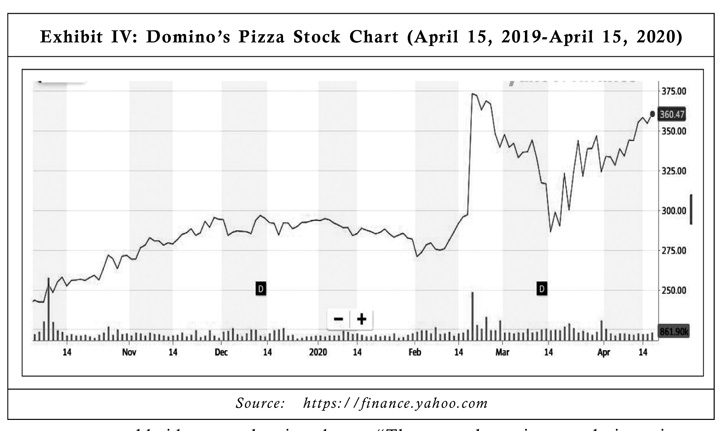
restaurants worldwide were shutting down. "The ones that win, or relative winners, are restaurants with drive-thrus, restaurants that have big delivery business, restaurants who do a lot of take-out business-who are known for takeout. If you are mostly an in-dining room type restaurant, I think you are going to struggle",32 said Peter Saleh (Saleh), analyst at global financial services company BTIG.
The Challenges
Though Domino's was by and large appreciated for its contactless delivery during the Covid-19 pandemic, it faced a backlash from critics and some of its employees for keeping its stores open. A campaign started against Domino's in Change.orgh by Domino's employee Issy Anna (Anna), accused the company of putting its employees at risk at a time when states had entered a lockdown or had urged residents to remain indoors to curb the spread of Covid-19. According to her, "We are being forced to work in cramped stores, many that are not equipped to deal with the situation at hand. Multiple employees are being forced to come in to work sick in fear of their jobs, while corporate refuses to bat an eye at the situation. "Contact-less delivery" has been anything but successful, as some stores remain open for carryout with people piling into the lobbies of these establishments even in the midst of shelter-in-place orders issued by many states, customers continue to give cash which multiple employees are handling, and hardly anyone actually utilizes the contact-less system." Anna further claimed that the delivery drivers did not have constant access to hand sanitizers or sanitizer sprays to properly disinfect the delivery bags. She wondered how a pizza service could be considered "essential" when there were other options such as people obtaining food from grocery stores or cooking themselves. She pointed out that American coffee company Starbucks Corporation had shut its stores temporarily and was giving each employee an option to take 30 days of paid sick leave.
In early April, Angharad Maddock, a Domino's employee in Llanelli, Carmarthenshire, UK, accused the company of dismissing her for raising concerns about lack of masks, hand sanitizers and social distancing at the store. Domino's refuted these allegations. A spokesperson for Domino's said that in addition to introducing contactless delivery, frequent handwashing and increased sanitization, the company had stopped its collection service and cash handling. It had also put screens in place and hazard tape on the floor "to help with social distancing for team members to adhere to."34
The company started facing more criticism when a store worker at Domino's in Eskbank, Midlothian, Scotland, died on April 10, 2020, after contracting the coronavirus. Nina Arnott, Domino's spokesperson, offered condolences to the employee's family on his demise but stated that the stores remained opened in support of the UK government's advice that food delivery services should play an important role in keeping people at home during the Covid-19 lockdown.
In another incident on April 12, 2020, a Domino's store in Crenshaw District in
Los Angeles was closed temporarily for thorough sanitizing after four of its employees tested positive for Covid-19. A group representing Domino's workers filed an emergency complaint with public health services firm Los Angeles County Public Health Department, demanding that they too shut the Domino's store. The complaint filed by delivery driver Angelica Olivares on behalf of herself and 10 co-workers stated, "Instead of closing the store temporarily and allowing exposed workers to quarantine for 14 days with pay... Domino's has stayed open without even providing protective equipment to workers or disinfecting the store".35
In mid-April, a pizza delivery boy tested positive for Covid-19 in New Delhi, India, which led to 72 homes being quarantined as a precautionary measure. Domino's issued a statement saying that this incident had nothing to do with it. The company reiterated that 100% of its delivery was "zero contact delivery" and that its employees in its stores were being temperature screened daily and followed hand washing protocols. Besides, the company was sanitizing restaurants, bikes, pizza boxes and hot bags every four hours, it said.36
Looking Ahead
Analysts appreciated Domino's strategy of gaining a larger portion of the pie during the Covid-19 lockdown. They opined that Domino's strong delivery infrastructure in addition to its having a strong digital consumer base helped it to capitalize on the contactless delivery trend. They pointed out that smaller independent pizza chains and restaurants lacking the resources stood to lose their share. According to Saleh, contactless delivery might not be a game changer but the service would become "table stakes and par for the course" in the pizza industry as the coronavirus was spreading continuously (see Exhibit V). Saleh added, "If you don't have that in this environment, you are going to lose share."37
At a time when rivals such as The Cheesecake Factory and Union Square Hospitality were announcing furloughs and layoffs respectively, Domino's announced plans to hire 10,000 employees in its US stores in March 2020 as the company was experiencing an increase in demand for its pizzas with more and more people working from home amid the pandemic. The company's UK division was also hiring more store workers and delivery drivers since more consumers were ordering online.
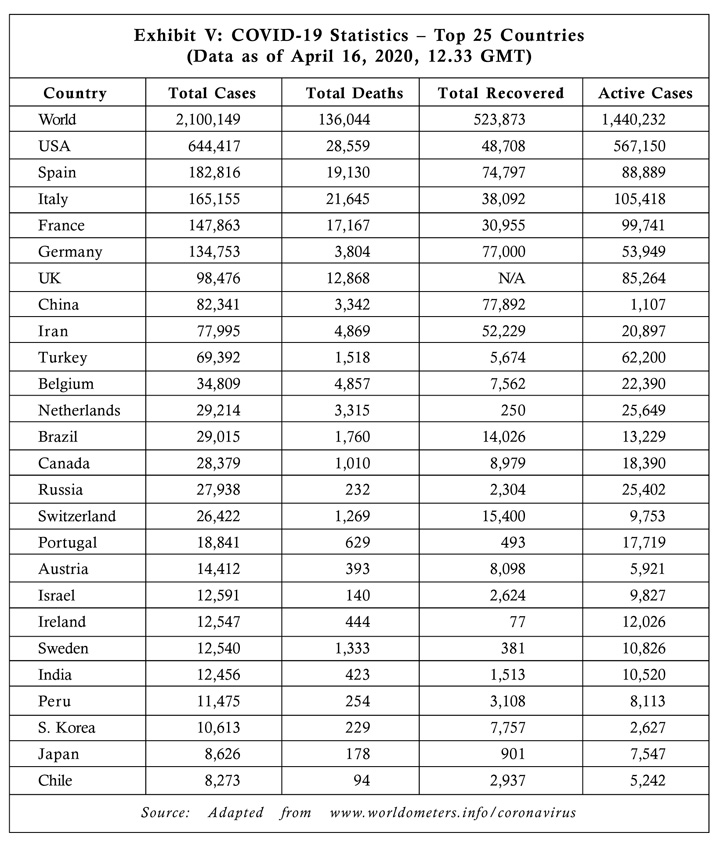
March 2020, the pizza giant's Australian division had already taken on over 2,000 people to serve consumers in the country.38 "While many local, state and federal governments [are issuing orders that close] dine-in restaurants, the opportunity to keep feeding our neighbors through delivery and carryout means that a small sense of normalcy is still available to everyone... Our corporate and franchise stores want to make sure they are not only feeding people but also providing an opportunity to those looking for work at this time, especially those in the heavily impacted restaurant industry",39 said Allison. Meanwhile, rivals such as Pizza Hut, Papa John's, and Jet's Pizza were also on a recruitment spree involving thousands of new employees.
Domino's was optimistic about cashing in on the trend as it borrowed $158 mn in its outstanding variable funding notes in a bid to improve its strong cash position and stay operational, though the company had $300 mn on hand to increase its financial flexibility.40 Reflecting the uncertainty of the global economy, Domino's, however, withdrew its fiscal 2020 guidance.
James McCann (McCann), CEO of McCann Investments, which invested in early-stage companies in the grocery tech, food tech, and consumer goods space, opined that while contactless delivery was booming in the wake of the Covid-19 crisis for companies such as Domino's, this service would be prevalent in the future based on several factors such as how quickly employees and customers accepted the practice and how long the threat of Covid-19 remained. He added, "If we have nine months of high virus threat, then physical distancing will be normal. We will have forgotten what the pre-normal was.
End Notes
- Keith Nunes, "Domino's Weathering Covid-19 Storm," www.foodbusinessnews.net, March 31, 2020.
- Anne Burdakin, "Domino's Pizza: A Lockdown Winner Any Way You Slice It," www.fool.com, March 28, 2020.
- Joanna Fantozzi, "Domino's Reports Q1 Same-Store Sales Growth and Withdraws Financial Guidance During COVID-19," www.nrn.com, March 31, 2020.
- "Domino's Pizza Announces Business Update," www.bloomberg.com, March 31, 2020.
- "Domino's Pizza Announces Business Update," http://dominos.gcs-web.com, March 30, 2020.
- Amelia Lucas, "Domino's Expects to Hire 10,000 Workers," www.cnbc.com, March 19, 2020.
- "Domino's Pizza First in Industry to Offer Mobile Ordering," www.webrtcworld.com, September 27, 2007.
- "DRU Drone by Flirtey Delivers Domino's Pizza in New Zealand," https://insideunmannedsystems.com, November 29, 2016.
- "Domino's Pizza Top 10 Innovations," https://aaronallen.com, May 18, 2018.
- "Domino's Pizza 2019 Annual Report," http://dominos.gcs-web.com
- Anne Burdakin, "Domino's Pizza: A Lockdown Winner Any Way You Slice It," www.fool.com, March 28, 2020.
- Jamie Ducharme, "World Health Organization Declares COVID-19 a 'Pandemic.' Here's What That Means," https://time.com, March 11, 2020.
- Sarah Newey and Anne Gulland, "What is Coronavirus, How Did It Start and How Big Could It Get?" www.telegraph.co.uk, April 10, 2020.
- "Global Coronavirus Cases Top Two Million: Johns Hopkins," www.cgtn.com, April 15, 2020.
- Alicia Kelso, "Why Pizza Chains are Weathering the Coronavirus Downturn Better Than Their Restaurant Counterparts," www.forbes.com, April 1, 2020.
- Alicia Kelso, "Why Domino's CFO is Confident the Pizza Chain will Gain Even More Market Share in 2020," www.forbes.com, January 15, 2020.
- Katie Arcieri, "Pizza Chains Aim for Larger Slice of Contactless Deliveries During Coronavirus," www.spglobal.com, April 6, 2020.
- Daniel B Kline, "Domino's Offers Contact-Free Delivery," www.fool.com, March 17, 2020.
- "Coronavirus: McDonald's, Domino's Pizza Introduce Contactless Delivery," www.deccanherald.com, March 16, 2020.
- Bhumika Khatri, "Domino's is Now Delivering Essentials in Partnership with ITC Foods," https://inc42.com, April 11, 2020.
- "A Letter to Domino's Customers from Ritch Allison, CEO of Domino's Pizza, Inc.," https://biz.dominos.com
- Ritch Allison, "Domino's CEO Pens a Letter Detailing the Impact of Covid-19 on Its Worldwide Business," www.franchising.com, April 2, 2020.
- Bill Peters, "Domino's Eyes Massive Hiring Spree While Coronavirus Ravages Restaurant Industry," www.investors.com, March 19, 2020.
- Alicia Kelso, "Why Pizza Chains are Weathering the Coronavirus Downturn Better Than Their Restaurant Counterparts," www.forbes.com, April 1, 2020.
- Michael Holan, "Domino's to Donate 10 Million Slices of Pizza Across US," https://nypost.com, April 7, 2020.
- "Domino's 6,126 Stores Give Communities 200 Pies Each," www.pizzamarketplace.com, April 6, 2020.
- John Ballard, "Domino's Pizza Reports Sales Increase Amid COVID-19 Pandemic," www.nasdaq.com, March 31, 2020.
- Jonathan Maze, "Not Even Domino's Can Escape the Coronavirus Impact," www.restaurantbusiness online.com, March 30, 2020.
- Alicia Kelso, "Why Pizza Chains are Weathering the Coronavirus Downturn Better Than Their Restaurant Counterparts," www.forbes.com, April 1, 2020.
- Bill Peters, "Domino's Eyes Massive Hiring Spree While Coronavirus Ravages Restaurant Industry," www.investors.com, March 19, 2020.
- John Ballard, "Domino's Pizza Reports Sales Increase Amid COVID-19 Pandemic," www.nasdaq.com, March 31, 2020.
- Kate Taylor, "Dominos-Papa-Johns-and-more-Chains-Thriving-Amid-Coronavirus," www.businessinsider.com, April 2, 2020.
- Issy Anna, "Close Domino's Pizza Due to COVID-19 Pandemic," www.change.org.
- "Coronavirus: Domino's Denies Sacking Staff Over Safety Concerns," www.bbc.com, April 4, 2020.
- "L.A. Domino's Closed for Sanitizing After Workers Say They're at Risk of Coronavirus," www.dailynews.com, April 11, 2020.
- "Pizza Delivery Boy Tests Positive for COVID-19: Zomato and Domino's Issue Clarification," www.dqindia.com, April 16, 2020.
- Katie Arcieri, "Pizza Chains Aim for Larger Slice of Contactless Deliveries During Coronavirus," www.spglobal.com, April 6, 2020.
- Harry Wise, "Domino's Pizza Cancels Dividend Despite the Coronavirus Lockdown Causing Huge Rise in Demand for Deliveries," www.thisismoney.co.uk, March 27, 2020. 39. Anne Burdakin, "Domino's Pizza: A Lockdown Winner Any Way You Slice It," www.fool.com, March 28, 2020.
- Julie Littman, "Domino's US Same-Store Sales Growth Drops by Half in Q1," www.restaurantdive.com, March 31, 2020.
- Katie Arcieri, "Pizza Chains Aim for Larger Slice of Contactless Deliveries During Coronavirus," www.spglobal.com, April 6, 2020.